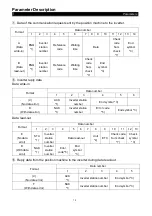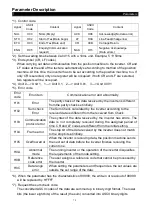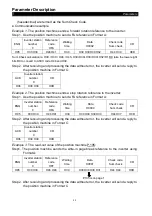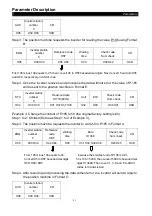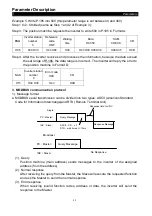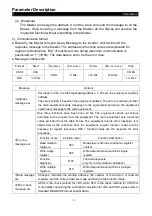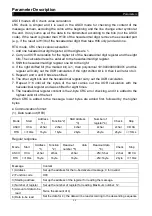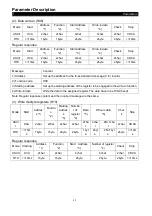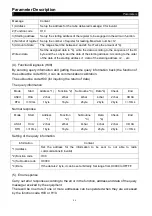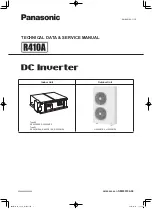
Parameter Description
Parameters
84
ASCII mode's LRC check value calculation:
LRC check is simpler and it is used in the ASCII mode for checking the content of the
message domain, excluding the colon at the beginning and the line change enter symbol at
the end. It only sums up all the data to be transmitted according to the bite (not the ASCII
code). If the result is greater than H100 of the hexadecimal digit, remove the exceeded part
(e.g., if the result is H136 of the hexadecimal digit, then take H36 only) and add one.
RTU mode, CRC check value calculation:
1. Add one hexadecimal digit register. All the digits are 1.
2. Carry out XOR calculation for the higher bit of the hexadecimal digit register and the eight
bits. The calculated result is entered to the hexadecimal digit register.
3. Shift this hexadecimal digit register one bit to the right.
4. If the right shifted bit (the marked bit) is 1, then polynomial 1010000000000001 and this
register will carry out the XOR calculation. If the right shifted bit is 0, then it will return to 3.
5. Repeat 3 and 4 until 8 bits are shifted.
6. The other eight bits and the hexadecimal register carry out the XOR calculation.
7. Repeat 3~6 until all the bytes of the text carries out the XOR calculation with the
hexadecimal register and was shifted for eight times.
8. The hexadecimal register content is the 2-byte CRC error checking, and it is added to the
highest valid bit of the text.
When CRC is added to the message, lower bytes are added first, followed by the higher
bytes.
● Communication format:
(1). Data read-out (H03)
Mode
Start
Address
*1)
Function*2)
Start Address
*3)
Number of
register *4)
Check
Stop
ASCII
H3A
2char
2char
4char
4char
2char
0D 0A
RTU
>=10ms
1byte
1byte
2byte
2byte
2byte
>=10ms
Regular response
Mode
Start
Address
*1)
Function
*2)
Read-out data
number *5)
Read-out data
*6)
Check
Stop
ASCII
H3A
2char
2char
2char
…2N×1char
2char
0D 0A
RTU
>=10ms
1byte
1byte
1byte
…2N×1byte
2byte
>=10ms
Message
Content
1) Address
Set up the address for the to-be delivered message; 0 for invalid.
2) Function code
H03
3) Starting address
Set up the address of the register for reading the message.
4) Number of register
Set up the number of register for reading. Maximum number: 12.
5) Amount of data to be
read
Twice the amount of 4)
6) Data to-be read
Set the data for 4); the data will be read according to the descending sequence









